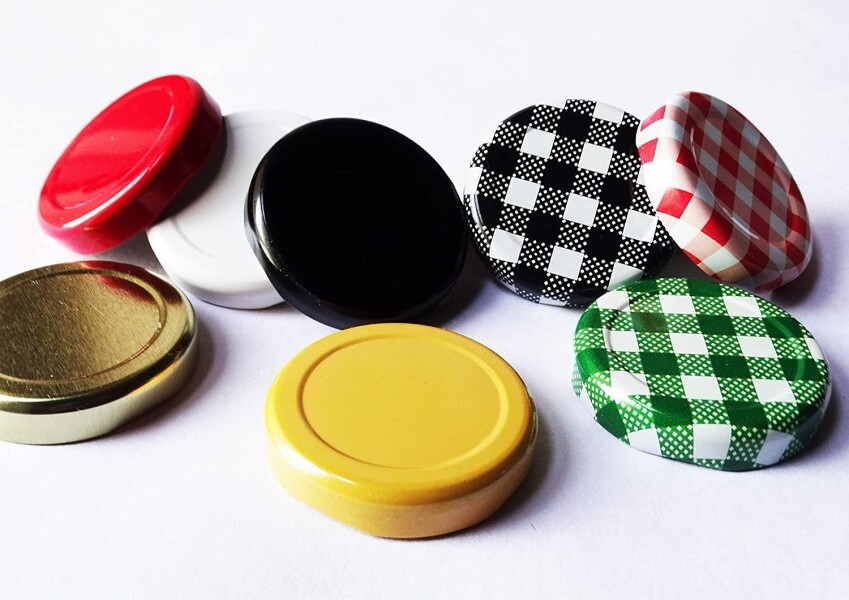Lug caps are commonly used in the food and beverage industry because they provide a secure seal for the container, helping to preserve the freshness and quality of the product. This is particularly important for products that are perishable, such as dairy products, juices and sauces. Lug caps, also known as twist-off caps or screw-on caps, provide a secure and reliable sealing solution for jars.
Lug caps are also efficient for use in high volume packaging operations. They can be applied and removed quickly, which can help to speed up the packaging process and increase productivity. This is particularly important in the food and beverage industry where speed and efficiency are often key factors in determining the success of a product.
Lug caps are also easy to open and close, making them convenient for the consumers.
Primarily, two types of lug caps are used in the food industry: Plain and checkered lug.
Plain lug caps and checkered lug caps are two types of lug caps that are used on food containers.
Plain lug caps are simple, smooth-sided caps that screw onto the container. They have a raised ring (lug) on the inside of the cap, which locks the cap and container together to ensure a tight seal, which helps to keep the food inside fresh. These caps are simple and easy to use, and are suitable for a wide range of products.
Checkered lug caps, also known as safety lug caps, have a raised, ridged design on the outside of the cap. This design provides a better grip, making it easier to open and close the cap. These caps also have a raised ring (lug) on the inside of the cap, which locks the cap and container together to ensure a tight seal, which helps to keep the food inside fresh. Checkered lug caps are commonly used for products that have a high acidity, such as pickles and sauces, to ensure a better seal.

Both plain and checkered lug caps can be used in a wide range of food products, and are commonly used in canning industry.
In this article, I will discuss the 5 best practices for using lug caps on glass jars in order to achieve the best possible results.
-
Choose the right size lug cap for your glass jars
It is important to use a lug cap that fits the size and shape of your jar. A lug cap that is too small may not provide a proper seal, while a lug cap that is too large may be difficult to twist on and off. It is also important to consider the neck finish of the jar, as lug caps are designed to fit specific neck finishes. For example, a lug cap with a 70 mm diameter may fit a jar with a 70 mm neck finish, but may not fit a jar with a different neck finish.

2. Use a lug cap with the proper sealing mechanism
There are several types of lug cap available, each with a different sealing mechanism. The most common sealing mechanisms are gasket seals, foil seals, and induction seals. Gasket seals use a rubber gasket to create a tight seal around the jar neck. Foil seals have a layer of foil that is peeled back to expose the opening in the cap. Induction seals use a layer of aluminum foil that is bonded to the cap and sealed to the jar neck using induction heating.

3. Properly apply the lug cap to the glass jars
To properly apply a lug cap to a jar, first clean the jar neck and the inside of the lug cap to remove any dirt or debris. Next, align the lug cap with the jar neck and twist it on until it is secure. Avoid overtightening the lug cap, as this can cause the jar to break or the lug cap to become difficult to remove. If using a lug cap with a gasket seal, make sure the gasket is properly seated in the cap and not twisted or damaged.

4. Store glass jars with lug caps properly
To ensure the best possible sealing performance, it is important to store jars with lug cap properly. Avoid stacking jars on top of each other, as this can cause the lug cap to become misaligned or damaged. Instead, store jars in a single layer on a flat, stable surface. Avoid storing jars in extreme temperatures, as this can cause the lug caps to expand or contract and affect the seal.
5. Inspect lug caps regularly
It is important to regularly inspect lug cap for any signs of wear or damage. Look for cracks or deformities in the lug caps or gasket, as these can affect the sealing performance. If a lug cap shows signs of wear or damage, replace it to ensure a proper seal.
In summary, lug caps are widely used in the food and beverage industry due to the tight seal they provide, preserving the freshness and quality of the product. Using lug caps on glass jars is a reliable and effective way to seal and store products. By following the best practices outlined in this article, you can ensure that your lug caps are applied and used properly to achieve the best possible sealing performance.
Looking for caps/closures to top up your brand? We have an expert team of product specialists, designers, and engineers to help you select the right caps/closures for your product. Connect with us at: sales@ajantabottle.com
You can also shop from more than 200+ glass bottles and glass jars along with caps/closures on www.ajantabottle.com – India’s first ever comprehensive glass bottle and glass jars e-commerce portal.
If you have any questions or comments regarding glass bottles and jars, please visit https://ajantabottle.com/
For more blogs and videos on glass packaging, visit https://www.ajantabottle.com/blog/
For the latest updates on glass packaging, subscribe to our
*YouTube channel: https://www.youtube.com/c/Ajantabottle
*LinkedIn Page: https://www.linkedin.com/company/ajantabottle
*Facebook Page: https://www.facebook.com/glassbottleindia
*Instagram Page: https://www.instagram.com/ajantabottle/
#blogging #contentmarketing #SEO #digitalmarketing #onlinemarketing #socialmediamarketing #contentcreation #blogger #lugcaps #packagingdesign #glassbottlecaps #capsandclosures






